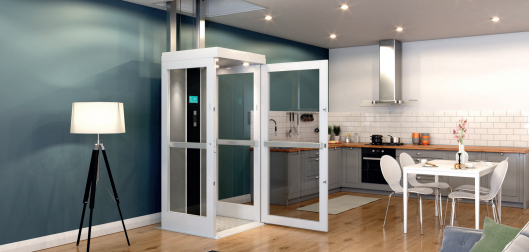What Lift Is Right For You – Elevator in Hoistway or Thru-Floor?

There are many home elevators* for hoistways on the market. Hoist way elevators are often used in new construction and existing construction when there are stacked closets. Houston is booming with three to five-story townhomes. I am unsure if an elevator in a five-story townhome is a convenience, luxury, or absolute necessity. Our favorite home elevators are the Savaria Eclipse Counter-Weighted Chain Drive Residential Elevator and the Savaria Inifiniti Hydraulic Residential Elevator. Home Elevators add convenience, luxury, and value to your home. Home elevators give you and all family members the ability to enjoy all the floors of your home effortlessly.
For Houston and surrounding areas, due to the possibility of ground flooding, we always recommend the Eclipse for the following reasons:
1. No separate machine room is required. The elevator’s motor and electronics are at the elevator shaft’s top. This design reduces the space required for a home elevator, reduces noise, and protects vital equipment from flooding,
2. 1,000 pound weight capacity,
3. Available Car Sizes are 36″ x 48″, 36″ x 60″, 40″ x 54″ and special order sizes (smaller to larger or in between),
4. For Safety, the elevator only works when all doors and the accordion gate are closed,
5. Uninterruptible Power Supply (UPS). If the power ever goes off, the UPS is capable of lowering the cab to the ground floor,
6. Cab Lights. The interior cab lights are on a timer. The lights turn on automatically when the elevator is in operation. After you exit the elevator, closing the door and gate, the lights will automatically turn off after five minutes, and
7. Homing to a selected floor. This is a great feature for homes in flood plains. After five minutes of non-use, the elevator is automatically set to home to the top floor or any floor you choose. You can order the elevator to home to any floor, or it can wait for you on the last floor it was called to.
The Eclipse is an affordable, low-maintenance residential elevator. The geared chain drive provides a stable ride. The compact design can fit when ceilings are as low as 96” on the upper floor. At the same time, you can have a cab as wide as 48”.

Through Floor elevators are also known as home elevators, home lifts, closet elevators, bedroom elevators, mini lifts for home, vacuum elevators, or shaftless elevators. Currently, there are five through-the-floor elevators, including the Bruno Connect, Pollock, PVE, Savaria Telecab, Savaria VueLift, and Stiltz.

Depending on the brand, they work off winding cable, hydraulic, or vacuum. They range in weight capacity from 375 lbs to 845 lbs. Some models run from 120 VAC, others from 240 VAC. All of them have emergency lowering in case of a power outage. Also, all of the home elevators can be operated from the cab or through the remote call/send stations located on each floor. Their small footprint makes them an excellent choice for existing construction. Depending on your home and your needs, you can choose a lift for one rider, two riders, three riders, or a wheelchair with a rider and an extra person. They can be placed in a closet, bedroom, living area, and endless options. The elevator can go through a floor or attach to a balcony. Except, they cannot be placed in a garage without a hoist way due to the possibility of fumes traveling from vehicles in the garage into living areas. When your elevator is upstairs you can walk under the elevator and have open space if you need it for entertaining. When the elevator is downstairs, you can walk across the floor covering the elevator on the second floor. Some models require constant pressure on the controls for operation, others have automatic operation. One of the main reasons a customer will choose a through-the-floor elevator instead of a hoistway elevator is construction cost savings.
Construction costs for a through-the-floor elevator are as low as $1,500, whereas shaftway hoistway construction for two floors starts at about $5,000. The through-the-floor elevators can be installed sometimes in as little as two weeks, including construction and lead time from the manufacturer. Hoistway elevators normally take three to six weeks, depending on construction time and lead time from the manufacturer.
* Please do your own research to determine which product is safest and best for you. The list of manufacturers is for your convenience and does not constitute an endorsement of any product by us. We are happy to answer any questions you may have.
